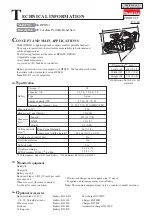
9
6.
Check the blade carefully for cracks or
damage before operation. Do not use saw
blade which are damaged or deformed.
7.
Use only saw blades recommended by the
manufacturer and which conform to EN847-1,
and observe that the riving knife must not be
thicker than the width of the cut by the saw
blade and not thinner than the body of the
blade.
8.
Always use accessories recommended in this
manual. Use of improper accessories such as
abrasive cut-off wheels may cause an injury.
9.
Select the correct saw blade for the material to
be cut.
10.
Do not use saw blades manufactured from
high speed steel.
11.
To reduce the emitted noise, always be sure
that the blade is sharp and clean.
12.
Use correctly sharpened saw blades. Observe
the maximum speed marked on the saw blade.
13.
Do not cut metal objects such as nails and
screws. Inspect for and remove all nails,
screws and other foreign material from the
workpiece before operation.
14.
Knock out any loose knots from workpiece
BEFORE beginning to cut.
15.
Do not use the tool in the presence of
flammable liquids or gases.
16.
For your safety, remove the chips, small pieces,
etc. from the work area and table top before
plugging the tool and starting operation.
17.
The operator is adequately trained in the use,
adjustment and operation of the tool.
18.
Keep hands and make your bystander and
yourself position out of path of and not in line
with saw blade. Avoid contact with any
coasting blade. It can still cause severe injury
and never reach around saw blade.
19.
Be alert at all times, especially during
repetitive, monotonous operations. Do not be
lulled into a false sense of security. Blades are
extremely unforgiving.
20.
Make sure the shaft lock is released before the
switch is turned on.
21.
Before using the tool on an actual workpiece,
let it run for a while. Watch for vibration or
wobbling that could indicate poor installation
or a poorly balanced blade.
22.
Wait until the blade attains full speed before
cutting.
23.
The tool should not be used for slotting,
rabbetting or grooving.
24.
Refrain from removing any cut-offs or other
parts of the workpiece from the cutting area
whilst the tool is running and the saw head is
not in the rest position.
25.
Stop operation immediately if you notice
anything abnormal.
26.
Turn off tool and wait for saw blade to stop
before moving workpiece or changing settings.
27.
Unplug tool before changing blade, servicing
or not in use.
28.
Some dust created from operation contains
chemicals known to cause cancer, birth
defects or other reproductive harm. Some
examples of these chemicals are:
−
lead from lead-based-painted material and,
−
arsenic and chromium from
chemically-treated lumber.
Your risk from these exposures varies,
depending on how often you do this type of
work. To reduce your exposure to these
chemicals: work in a well ventilated area and
work with approved safety equipment, such as
those dust masks that are specially designed
to filter out microscopic particles.
29.
Connect the tool to a dust collecting device
when sawing.
30.
When fitted with laser, no exchange with
different type of laser is permitted. Repairs
shall only be carried out correctly.
31.
Even when the tool is used as prescribed it is
not possible to eliminate all residual risk
factors. The following hazards may arise in
connection with the tool’s construction and
design:
−
Damage to health resulting from hand-arm
vibrations if the power tool is used over a
longer period of time and is not operated
or serviced correctly.
−
Injury or damage caused by loose tool
attachments which can unexpectedly slide
out/from the power tool due to sudden
damage, wear or improper mounting.
WHEN USING IN MITER SAW MODE:
32.
Do not use the saw to cut other than wood,
aluminum or similar materials.
33.
Do not perform operation freehand when
cutting workpiece in an area close to saw
blade. The workpiece must be secured firmly
against the turn base and guide fence during
all operations.
34.
Make sure that the turn base is properly
secured so it will not move during operation.
35.
Make sure that the arm is securely fixed when
beveling. Tighten the lever clockwise to fix the
arm.
36.
Make sure the blade does not contact the turn
base in the lowest position and is not
contacting the workpiece before the switch is
turned on.
37.
Hold the handle firmly. Be aware that the saw
moves up or down slightly during start-up and
stopping.
38.
Replace the kerf board when worn.
Содержание LH1200FL
Страница 110: ...110 ...
Страница 111: ...111 ...
Страница 112: ...112 Makita Corporation Anjo Aichi Japan www makita com JM2338B029 ...










































